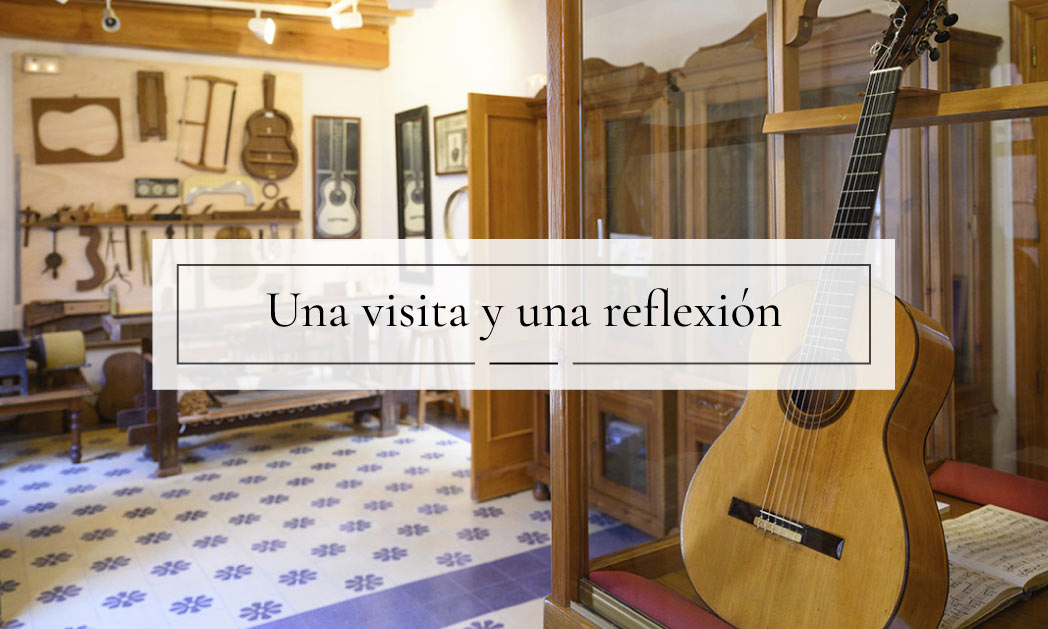I am writing this article as a consequence of a trip and a publication in our networks. I never thought that a pleasure visit, which was intended to satisfy my curiosity, would lead to so much and for so little, so here I am once again making demands and insisting, and I will continue to do so, until I achieve my goal: to be heard and to make the action a reality and not a dream. As the situation has become surreal, I have taken the liberty of making a nod to the work ‘Ceci n’est pas un pipe’ by the marvellous artist René Magritte.
The trip to the Antonio de Torres House-Museum
My family and I were spending a few days in the province of Almeria, because my partner’s family is from there, and after watching this video we decided to visit the House-Museum of Don Antonio de Torres located in Calle Real de la Cañada 58 in Almeria. Our intention was to see the Torres – Manuel Ramírez guitar restored by the luthier Carlos González, as we were the ones who put him in contact with the woman who sold it to him and because this instrument was in very bad condition and we know the good work that this maker and researcher of antique instruments does. I invite you to read the following article published in our blog: Manuel Ramírez y sus Torres | Guitarras Ramíre
Arrival at the House-Museum
On arriving at the Cañada area we looked for the beautiful façade with the commemorative plaque. The peeling tiles announced what we would find inside, that and the woman sitting at the door with her fan, Remi, who is in charge of opening and showing the museum on Saturdays, as this is the only day it is open. At the entrance was the workbench that we gave to the town hall after the monographic exhibition that the Museo de la Guitarra de Almería dedicated to us in 2015, of course without a sign or any sign indicating where it came from
Disappointment when touring the museum
The visit didn’t look very good, but after passing through the entrance arch and entering the area where some chairs are placed as a small concert hall, also where there is a dining room at the back and where the stairs are located, a suffocating heat began to invade us, accentuated by an intense humidity, which increased as we climbed the steps. Upstairs, where there was a small bench, hanging tools, machines and a neglected folder with templates and ornamentation, as well as some guitars on display from other builders, sweat began to bead on our bodies, which I must point out is quite extraordinary for me, by the way. So you can imagine, to put it in a joking manner, the marvellous state in which the instruments were kept, not to mention the guitar that had been stored in the chest on the ground floor without a string for who knows how long. Apparently there was a television screen projecting some information from the builder that stopped working and, of course, was never replaced.
Reflections after the visit
And here ends the chronicle of our visit to this space that has only been open for one year (since 2023). My partner and I were deeply impressed and saddened. How is it possible that the figure of the guitar maker who shaped today’s Spanish guitar (classical and flamenco) is treated in this way? A world-renowned figure, with guitars that form part of important collections, a reference for builders from all over the world who have based themselves on him and have even paid tribute to him by reproducing his instruments, with publications on his work by important musicologists from different countries, and for whom countless international and national guitarists would kill to have one of his guitars?
Possible solutions and improvements
So many things could be done and would attract so many people who love this instrument… I may not be the one to imagine how to promote, nurture and care for this space, but I am going to allow myself the licence to do it. Let’s imagine that the Museo de la Guitarra de Almería would be connected by a special bus with this House-Museum (indicating the days and times of the service), that it would be filled with music again with concerts by national and international guitarists (apparently this is planned, hopefully they will fix the thermal conditions for it to be successful) and that specialised talks would be held. That the Town Hall of Almería support its guitar makers and invite and subsidise them to make copies of their instruments as a tribute to this figure and thus fill the museum and the house-museum with instruments. That it would attract researchers to present their theories and that all this information would be recorded and visible in this space or in the Guitar Museum. To link up with the Guitar Museum in the first place, but also with related associations, clubs and foundations or museums to exchange content and knowledge. That courses in luthiery be organised to make some of his instruments, that books on this character be sold and that new publications, studies and research be financed. That collectors be invited to temporarily lend their original Torres and that they be allowed to make studies on them or concerts with them by recognised specialists (we have one that we have always offered free of charge, assuming that the other party is responsible for the transport of works of art and their insurance, not to mention their correct conservation and security). So many things can be done to create a lively and attractive space that is also profitable, but I will not be the one who can do it, since, for the moment in my city (Madrid) we unfortunately lack a museum of instruments like Barcelona has, despite having important traditions, professionals, public funds forgotten in warehouses or exposed in any way (in the best of cases) and collectors willing to participate in this beautiful project that belongs to all of us who like culture and art, because it is everyone’s heritage and we have the right to enjoy it and feel it alive.
Final reflection
However, it is so complicated for the councillors or politicians of the day to think beyond hanging a medal on their hands… For example, as we can see with this museum that has only been open for a year. They can’t see that, for example, festivals like the one in Cordoba or Petrer fill up with guitarists, enthusiasts and curious people from all over the world, that a large number of foreigners come to our shop every year… They don’t see this or they don’t want to see it, but culture, in this case the culture of music and the craft of creating instruments, are very attractive and identify us. They are intangible heritage. Hopefully this neglect and disinterest will change soon and hopefully this message in a bottle will reach the right person and, finally, hopefully it will have enough of an impact to make them react and change the panorama which, for the moment, is discouraging.


